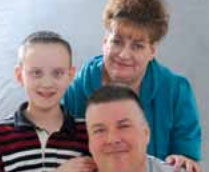Forty-five-year-old Gregory Kava faced a struggle with a diabetic foot ulcer that could have claimed his right leg, but the team at the Wound Care Center® at Robert Wood Johnson University Hospital Rahway refused to let that happen.

The resident of Middletown, N.J., and retired New York City Transit Authority worker had dealt with a non-healing wound on his right foot for years before visiting the Center in January 2009. After having a toe amputated at another facility in November 2008, he contracted gangrene as well as an infection with methicillin-resistant Staphylococcus aureus (MRSA) that required open-heart surgery after spreading to his heart through his bloodstream. The six-inch wound left when physicians had to remove the infected area around the site of the amputated toe caused Mr. Kava to visit the Center at his family’s recommendation.
Putting a Treatment Plan in Place
“Things looked pretty bad for Mr. Kava when he came to us,” says Laurie Yorke, case manager at the Center. “He was at risk of losing his leg below the knee. Our initial priority was to clean the wound by removing anything gangrenous, which unfortunately included all of his toes. Once that was accomplished, we began working toward the ultimate goal of final wound closure.”
For five months, Mr. Kava wore a portable wound vacuum assisted closure (VAC) device to constantly draw fluid out of the wound. In July 2009, four weeks after having the wound VAC removed, an advanced biological dressing that encourages new skin growth called Apligraf® was applied to Mr. Kava’s wound. By the end of August, after a second Apligraf application, the wound was fully healed.
“It wasn’t an easy process, but I never doubted the team at the Wound Care Center for a moment,” Mr. Kava says. “The people there became my friends, and over time I began to look forward to my visits. The team at the Center always made me feel better, even if I couldn’t see any progress. It’s great to be able to put on a pair of sneakers and go for a walk now without worrying about pain or infection.”
After achieving closure of the wound on Mr. Kava’s right foot, his friends at the Center healed a smaller, less complex wound on his left foot in eight weeks using the same methods.
“If a wound has not improved significantly in four weeks or healed entirely in eight weeks, it is considered chronic,” says Ann Lubas, director of the Center. “Our outpatient treatment center provides technically advanced, interdisciplinary care that has proven highly effective in healing chronic wounds that resist conventional therapy. We have a professional team that is highly trained in the specialized, comprehensive care of problem wounds. We’re here to help.”